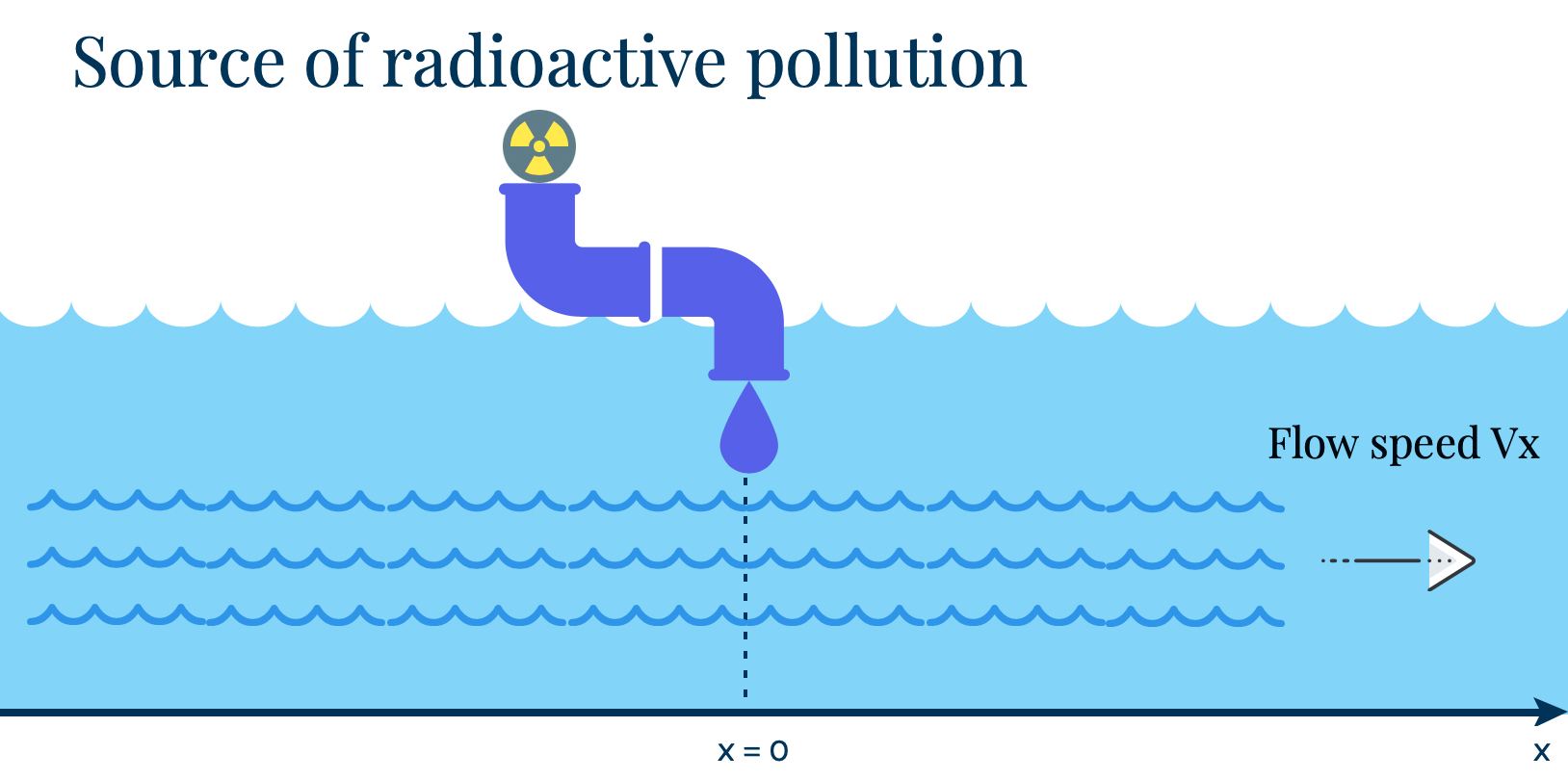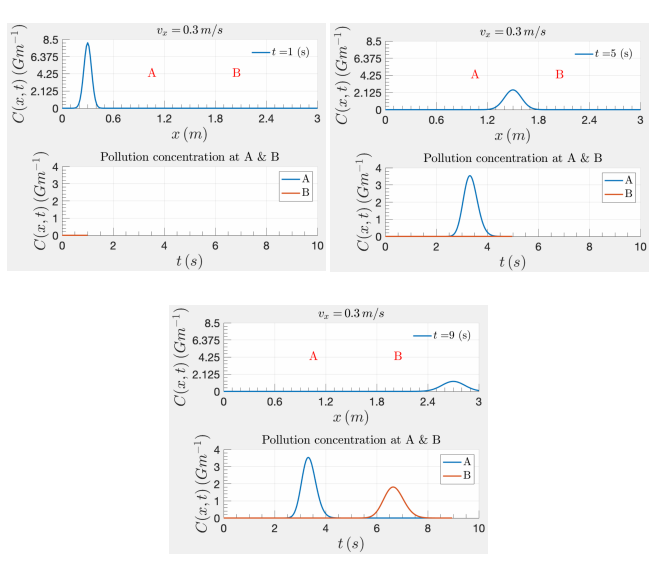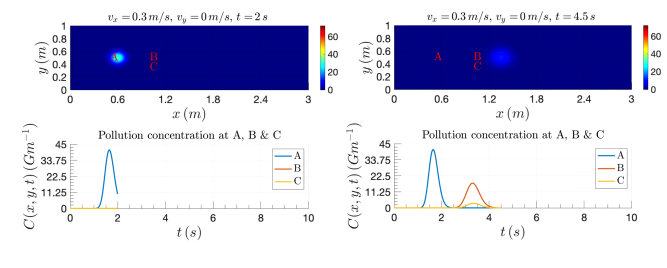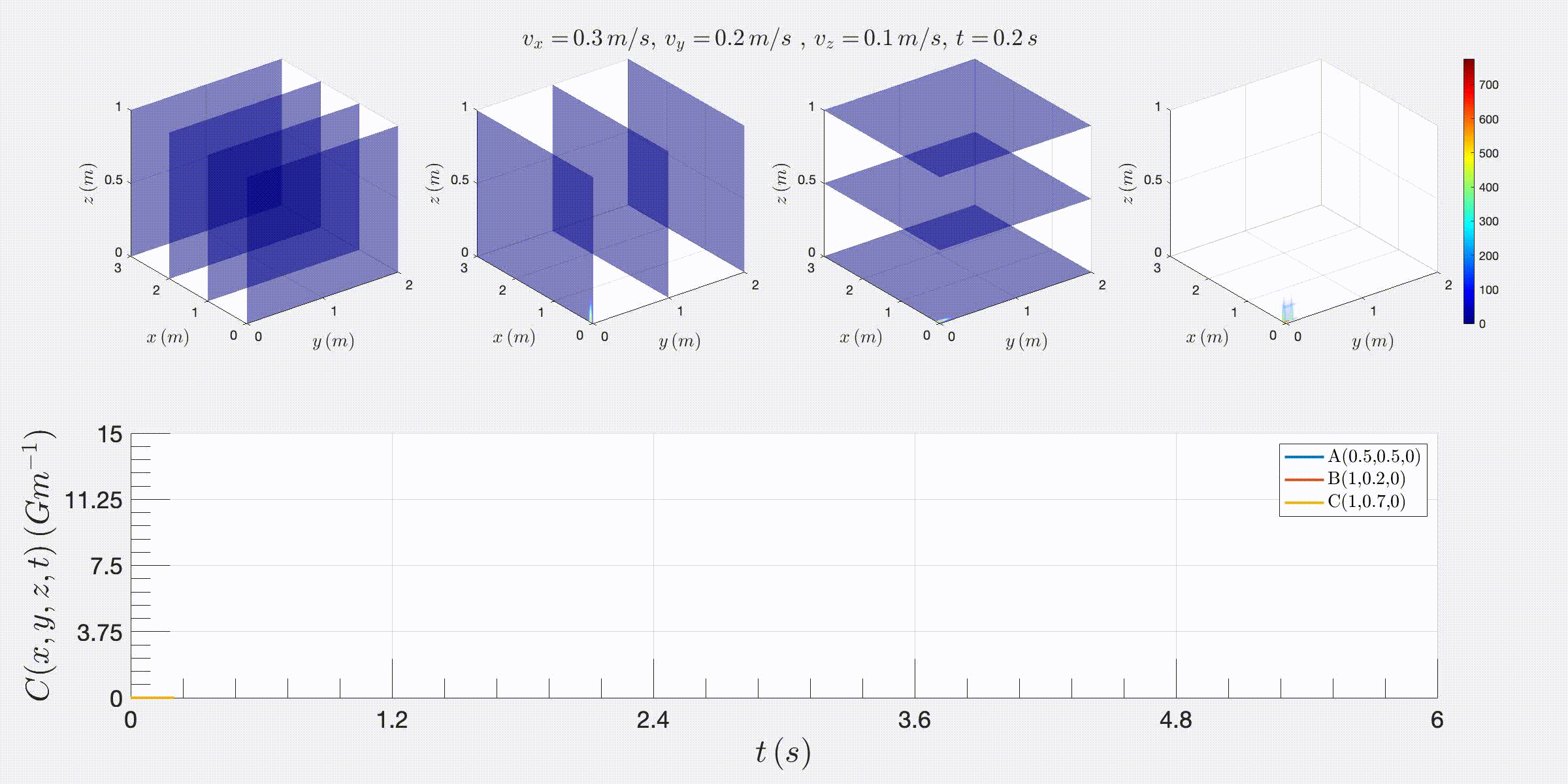Numerical simulation of radioactive pollution diffusion in 3D stream
TRANSPORT EQUATION IN THREE DIMENSIONS
The transport of pollution in a three-dimensional stream with the diffusion coefficient flowing with velocity v, when there is source or sink , can be described by the convection-diffusion equation
| (1) |
where is the pollution concentration. The transport equation (1) in a Cartesian coordinate system, where the fluid is moving with the constant velocity of v can be represented as
| (2) | |||||
| (3) | |||||
| (4) |
where
- •
: the pollution concentration at location and time ,
- •
: the horizontal and vertical components of diffusion coefficient. For an anisotropic medium, like rivers and lakes, are unequal, while for an isotropic medium, the diffusion proceeds at the same rate in horizontal and vertical directions,
- •
: the flow velocity components in the , , and directions. They are constant in each spatial direction for the studied contaminated region,
- •
: the pollution emission at location and time .
Considering the boundary conditions, the pollution concentration must converge to zero as , , or tends to infinity
| (5) | |||
| (6) | |||
| (7) |
and the initial condition,
| (8) |
where is the released point-source pollution at location and time . In a 1D model in direction, represents the surface mass flux or total mass per unit area, where is the area scale of neglected dimensions. Similarly, in a 2D model in the direction, represents linear mass flux or total mass per unit length, where is the area scale of neglected dimension. The total mass of pollution at time must be equal to the number of undecayed pollution at time , i.e. . So, the boundary and initial conditions are
| (9) |
If the source of the contamination is radioactive material, the mass of undecayed material at time is given by the radioactive decay law
| (10) |
where is the decay constant for the induced radioactive material. For an instantaneous point-source pollution
| (11) | |||||
| (12) |
NUMERICAL RESULTS
To study the pollution diffusion from a radioactive source in a river or lake, we develop a computational toolkit in Matlab to solve the transport equation and calculate pollution concentration as a function of time at different locations.
Instantaneous release of radioactive pollution in a 1D pedagogical stream:

For the first implementation, we study the diffusion of radioactive pollution from an instantaneous release in a 1D water canal flowing at a constant speed. In the image above, we show the pollution release in a one-dimensional water canal flowing in the x direction with a constant speed vx. The Matlab scripts listed in Appendix A, create 2D motion plots (in AVI and GIF formats) for the evolution of pollution concentration.

FIG. 2: Few screenshots of 2D motion plots obtained from the Matlab toolkit that calculates the pollution diffusion obtained from instantaneous release from radioactive neutron source 16N (with a half-life T1/2 = 7.13 s) as a function of time t and distance x, in a water canal flowing with a constant speed vx = 0.3 m/s and a diffusion coefficient

Instantaneous release of radioactive pollution in a 2D pedagogical stream:
In this section, we study the diffusion of radioactive pollution from an instantaneous release in a 2D water stream flowing at constant speeds vx and vy in the x and y directions. The Matlab scripts listed in Appendix B, create 2D motion plots (in AVI and GIF formats) for the evolution of pollution concentration from a release at point ( x0, y0).

FIG. 3: Few screenshots of 2D motion plots obtained from the Matlab toolkit that calculates the pollution diffusion obtained from instantaneous release from radioactive neutron source 16N (with a half-life T1/2 = 7.13 s) at (x0 = 0 m, y0 = 0.5 m) as a function of time t and distances x and y, in a water river flowing with a constant speeds vx = 0.3 m/s and vy = 0.0 m/s and diffusion coefficients Dx = Dy = 0.001.

Instantaneous release of radioactive pollution in a 3D pedagogical stream:
In this section, we study the diffusion of radioactive pollution from an instantaneous release in a 3D water stream flowing at constant speeds vx, vy, and vz in the x, y, and z directions. The Matlab scripts listed in Appendix B, create 3D motion plots (in AVI and GIF formats) for the evolution of pollution concentration from a release at point (x0, y0, z0).

FIG. 3: Few screenshots of 3D motion plots obtained from the Matlab toolkit that calculates the pollution diffusion obtained from instantaneous release from radioactive neutron source 16N (with a half-life T1/2 = 7.13 s) at (x0, y0, z0) as a function of time t and distances x and y, in a water river flowing with a constant speeds vx = 0.3 m/s, vy = 0.2 m/s, and vz = 0.1 m/s and diffusion coefficients Dx = 0.001 Dy = Dz = 0.01.

